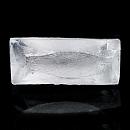|
Click on a letter above to view the list of gems. |
|
|
|
|
|
|
|
|
Halite |
|
| | |
| Discovery: Prehistoric; IMA status: Valid (pre-IMA; Grandfathered). | ||
|
| ||
|
Chemistry |
| ||||||||||||||||||||
|
| |||||||||||||||||||||
|
NaCl | |||||||||||||||||||||
|
|
Sodium Chloride | ||||||||||||||||||||
|
Molecular Weight: |
58.44 gm | ||||||||||||||||||||
|
Composition: |
| ||||||||||||||||||||
|
|
|||||||||||||||||||||
|
|
|||||||||||||||||||||
|
|
|
Classification |
|
|
| |
|
Halides | |
|
3/A.02-30 | |
|
|
3 : HALIDES
|
|
Related to: |
Halite Group |
|
Varieties: |
Huantajayite |
|
Synonyms: |
Common Salt, β-Halite, Halites, Martinsite (of Karsten), Muriate of Soda, Natrikalite, Rock Salt, Salt, Sodium Chloride, Saltspar |
|
|
|
|
Crystal Data |
|
|
|
|
|
Crystals normally cubic, to 1 m, rarely octahedral, elongated along [100] or [111]. Crystal faces often cavernous and stepped (hopper crystals). Massive. Coarsely granular to compact; columnar, stalactitic or capillary forms rare. |
|
|
None |
|
|
|
|
|
Physical Properties |
|
|
|
|
|
[100] Perfect, [010] Perfect, [001] Perfect |
|
|
Conchoidal |
|
|
Brittle |
|
|
2.0 - 2.5 |
|
|
2.168 (g/cm3) |
|
|
Rarely fluorescent; SW UV = red, green (organic inclusions), orange, LW UV = red, green orange. |
|
|
Not Radioactive |
|
|
Other: |
Soluble in H2O. Saline taste. Caution: Licking or ingesting raw halite in the "wild" could cause health problems due to unidentified admixed substances (such as alkaline compounds). |
|
|
|
|
Optical Properties |
|
|
|
|
|
Colorless or White when pure, Gray, Yellow, Orange, light to dark Blue, Purple, Pink to Red; Colorless to faintly tinted in thin section. |
|
|
Transparent to Translucent |
|
|
Vitreous |
|
|
1.5443 Isotropic |
|
|
0.000 (Isotropic) |
|
|
Moderately Strong |
|
|
Weak; The pleochroism is sometimes developed in colored material after being subjected to pressure. |
|
|
Weakly anisotropic due to stress. |
|
|
|
|
|
Occurances |
|
|
|
|
|
Geological Setting: |
Typically in sedimentary rocks of evaporite association, may form immense beds; also as volcanic sublimates, efflorescences, cave deposits. Crystals are common in multiphase fluid inclusions; may be included in other minerals as a product of intermediate-grade metamorphism. |
|
Common Associations: |
Anhydrite, Carnallite, Clay, Dolomite, Gypsum, Kainite, Kieserite, Polyhalite, Sylvite |
|
Common Impurities: |
Br, Fe, I, O |
|
Type Locality: |
Unknown (prehistoric) |
|
Year Discovered: |
Prehistoric |
|
View mineral photos: | |
|
|
|
|
More Information |
|
|
|
|
|
| |
|
|
|
|
Halite often forms as perfect cubes but also forms some unusual and interesting habits. One of the most interesting is called a "hopper" or "skeletal" crystal where only the edges of the crystal grow outward from the center leaving hollow, stairstep faces recessed toward the center of the crystal. Halite crystals are sometimes colored an attractive pastel pink by inclusions of bacterial debris that are trapped during crystallization in an evaporative lake. Halite crystals from Saxony-Anhalt and Lower Saxony, Germany have been found with amazing azure-blue color banding that is caused by the presence of Chloride gas. Halite
occurs worldwide. Well-studied deposits include:
around Hallstadt, Salzburg, and Hall, near
Innsbruck, Tirol, Austria. From Bex, Vaud, Switzerland. In Germany,
from Stassfurt-Leopoldshall, 34 km south of Magdeburg,
Saxony-Anhalt. Deposits with large crystals at Wieliczka
(Galicia) and Bochnia, Poland. At Girgenti and Racalmuto,
Sicily, Italy. In the Salt Range, Punjab, India. In
the USA, in the Michigan Basin, underlying Ohio, Michigan,
and New York; as numerous salt domes along the Gulf
Coast; and in the Permian Basin of Texas and New Mexico;
large crystals at the Potash Corporation of America
mine, Carlsbad potash district, Eddy County, New Mexico.
|
|
|
We
have not photographed our Halite gems. Please
check back soon. |
